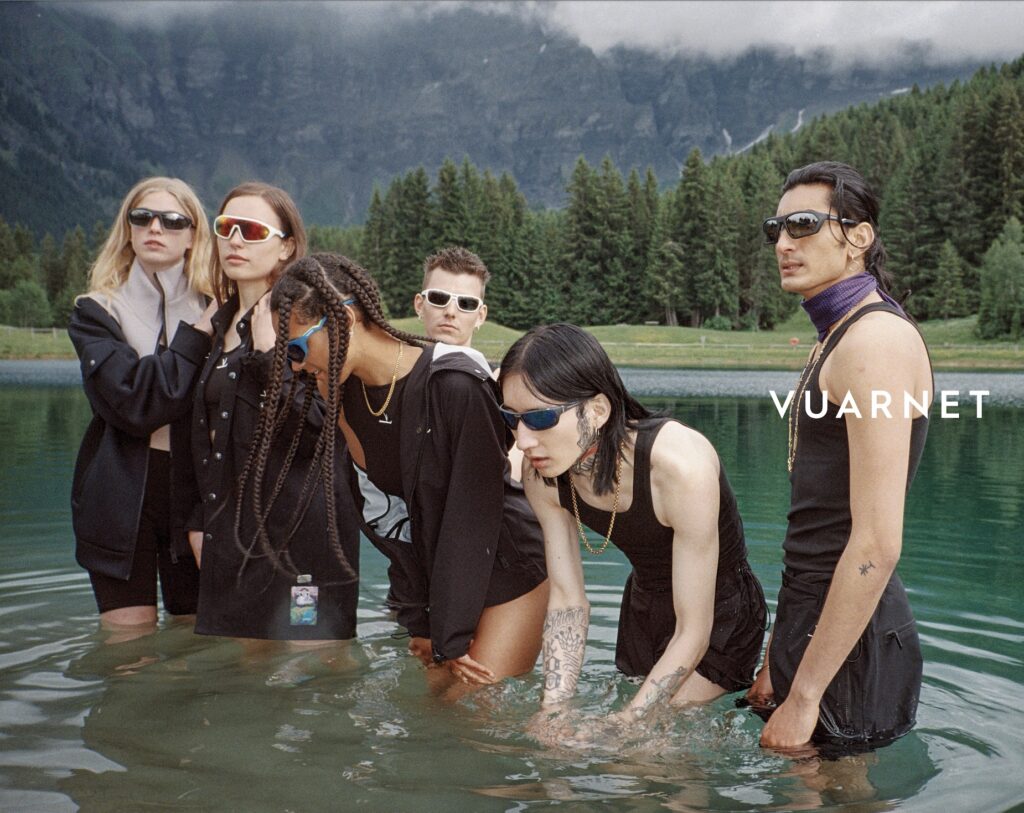Vuarnet’s New Lens
Although Vuarnet is typically known for sunglasses, Boramy Viguier might just convince you that it will be remembered for much more. His latest collection plays out in three formats: the ready-to-wear show, a mise-en-scène ensconced in the belly of Dover Street Market’s 3537 Marais space; a lookbook set against the backdrop of various sylvan and hilly milieux; and a vaguely erotic short film showcasing the playful but perfunctory appeal of Vuarnet’s new identity.
Founded by Jean Vuarnet and optician Roger Pouilloux in 1957, the brand was eminent in the world of sports eyewear and slope style. Viguier emerged as the contender to reproduce a similar impact on a contemporary audience. For Spring Summer 2023, he effortlessly blends tradition (locally produced clothing; practical items like mountain parkas and trekking trousers) with modernity (newly-developed and highly technical fabrics) resulting in an offering of sartorially-inclined mountain attire. Rendered in a mostly muted palette, the overarching inspiration stems from a wealth of archival imagery of alpinists in the 1960s.
“Usually in mountaineering, you have striking colours, but I prefer something more severe, austere – even in a positive brand – because it serves to underline the history of the brand,” Viguier said over Zoom from the Parisian apartment where he was scrutinising final edits of the short film with a video editor.

Is exploration something that comes naturally to you?
I like to do things that I didn’t know how to do before. I’m currently in the editing room working on the new campaign. I started to direct films over a year ago, so it’s a completely new thing for me, but I like it. I don’t have huge experience in that area so it’s been nice to explore. I am pretty free when it comes to my work and I am lucky enough to have a good boss who allows me to do what I want. Of course, there are commercial boundaries and natural boundaries, but I don’t feel stuck in either of those or feel like I must respond to a market or be careful about saying something.
What kind of exploring do you undertake before starting a new collection?
It’s very specific because, in a way, it’s a mountaineering brand; but it has a history in sunglasses too, and is deeply rooted in the French mountains. Mountaineering is such a big thing at the moment but we have such an extreme – in a way American – vision of it, which I love. But the vision of the French mountain is special. There’s a lot to discover. The fun part here is to try to create a mishmash between technical garments that can be used as a hiking parka or trekking trousers. It’s quite nice to design and imbue [everything] with a strong purpose. On the other end, I have created a line of garments that I would say are much more luxurious. [They’re] locally-made, cotton-based garments inspired by old-school alpine uniforms. It’s these two worlds that come together. It’s about finding a tension between what was mountaineering then and what is mountaineering now.
In what ways are you exploring new materials, methods, and technology each season – or with this collection, specifically?
It’s always nice to work with the latest materials that make outdoor clothing efficient, but I’m equally interested in finding a really good knit atelier in France that uses eco-friendly yarns with a small production and that, for example, is really conscious about doing the best jacquard to have well-made knitwear. I’m working on a hat with a really tiny French factory that is one of the last to do things this particular way. This is tradition: there is nothing fancy about this. It’s nothing groundbreaking in terms of innovation. When you think of mountaineering, it’s always really focused on the latest technology. This other aspect of the history of it is very interesting, like when I see old pictures of alpinists, of ski resort style in the ’70s, and Olympic winners in the ’60s. I want to try blending the two notions [of tradition and modernity].
How have you found exploring the brand’s history in sunglasses?
I’ve never done sunglasses before so it was a new exploration for me. I tried to look at new techniques this season like 3D printing based on new material, but we’re thinking of purchasing recycled nylon-based materials for the sunglasses. It’s not choosing a recycled thing just for the sake of it, but it’s for aesthetic reasons in terms of the textures that used products can bring to the table. With regards to production, we carefully choose how we produced them, which led to discovering new techniques that were in service of being conscious. When I choose to work with local French makers, I take inspiration from the sunglasses because we own the factory that does the lenses. I’ve tried to copy the sunglass process when it comes to the garments.
How does the short film play a role in this process?
I’m always thinking about the final outcome; so, six months ago, I was thinking about the film, the landscape, and the environment of the collection prior to its completion. It’s almost like creating a costume for a specific environment.
This interview has been lightly edited for clarity.



